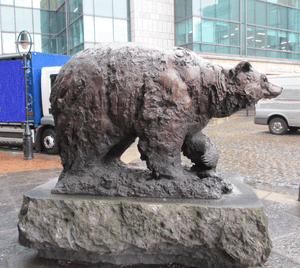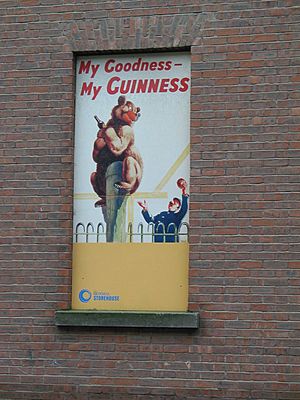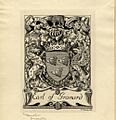Bears in Ireland facts for kids


Bears were once common in Ireland. However, they are now extinct on the island. The last bears died out around 1,000 to 500 BC.
Ancient Bears of Ireland
Ireland was once home to different types of bears. These powerful animals roamed the land for thousands of years.
Cave Bears and Brown Bears
The cave bear (Ursus spelaeus) lived in Ireland a very long time ago. It became extinct around 22,000 BC. Later, the brown bear (Ursus arctos) also lived here. These brown bears ate animals like red deer, wild boar, Irish hare, and Atlantic salmon.
Where Bears Lived
Irish bears often hibernated in caves during the cold months. Sometimes, bears died while hibernating. Their bones have been found by scientists and archaeologists. Famous places where bear bones were found include Poll na mBéar (Cave of the Bears) in County Leitrim and Aillwee Cave in County Clare. Bones have also been found in Lough Gur, County Kildare, and County Longford.
Archaeologists have even found bear teeth with holes in them. These teeth were likely worn as necklaces by early humans.
Early Human Activity
Scientists found a bear kneecap (called a patella) with cut marks on it. This shows that humans butchered bears for food. This bone was found in the Alice and Gwendoline Cave in County Clare. It dates back to about 10,860–10,641 BC. This is the earliest known sign of humans in Ireland!
Irish Bear DNA
Studies of bear DNA from Ireland show something interesting. The ancient Irish bear was a mix between the modern brown bear and the polar bear. This suggests that Irish bears might have bred with ancient polar bears during the Pleistocene Ice Age.
Why Bears Disappeared
Bears are believed to have died out in Ireland between 1000 and 500 BC. This was mainly due to two reasons:
- Habitat loss: Forests and wild areas where bears lived were cleared for farming and human settlements.
- Hunting: Humans also hunted bears, which reduced their numbers.
Bear Names and Legends
The word "bear" has a long history in the Irish language.
Old Irish Words for Bear
In Old Irish, there were three main words for bear:
- art: This word is very old and is related to the Greek word for bear, arktos.
- math: This word was also used for bear.
- beithir: This word originally meant "monster" or "beast." It later came to mean "bear" because of influence from Germanic languages like Norse and English.
Over time, the word art was used less often. The word math was combined with gamuin (meaning "calf") to make mathgamain. The word beithir changed to béar, which is similar to the English word "bear."
Bear Names in History
The old Irish words for bear, art and math, often appear in names. For example, the name Arthur is thought to mean "bear-man." Many famous Irish people and kings had names that included these words:
- Art mac Cuinn, Art Imlech, and Art mac Lugdach were legendary High Kings of Ireland.
- Art Óg mac Murchadha Caomhánach was a king in the 14th century.
- The name Artrí means "bear-king." Artrí mac Cathail was a king in the 8th–9th centuries.
- Surnames like MacMahon also come from these bear-related names.
Bears in Irish Stories
Bears sometimes appear in Irish mythology and folk tales. One example is the story of The Brown Bear of Norway.
Place Names with "Bear"
Since bears died out in Ireland before the Celts arrived, their name doesn't appear in many place names.
- The Beara Peninsula, Bear barony, and Bere Island are not named after bears. Their name comes from a different root, similar to Iberia.
- Lismaha (Irish Lios Matha), a townland in County Roscommon, might mean "bear ringfort." However, it could also mean "Matthew's ringfort."
Bears in Modern Ireland
Even though wild bears are gone, bears have been part of Irish life in other ways.
Bear-Baiting
In the past, a cruel sport called Bear-baiting took place in Ireland. This involved bears fighting other animals, like bulls. It was common in places like Belfast and Cork. In Dublin in 1726, a bear escaped during a baiting event.
Bears in Zoos
Dublin Zoo had two polar bears from the early 1980s until 2003. One female bear had behaviors that worried experts. A study found that bears need quiet time alone. This bear was later moved to a zoo in Hungary where her needs could be better met.
Rescued Bears in Wild Ireland
It is not possible to bring wild bears back to Ireland because there isn't enough natural habitat left. However, you can see brown bears in Ireland today! Three brown bears live at Wild Ireland, a 23 acres (9.3 ha) reserve on the Inishowen Peninsula. These bears were rescued from a private zoo in Lithuania.
Images for kids
-
The coat of arms of the Earls of Granard. It shows three bear heads. In British heraldry, bears are often shown wearing muzzles. This might be because there were no wild bears in Great Britain and Ireland.



